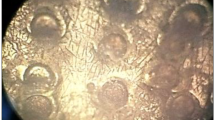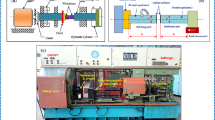Abstract
This work aims to determine the root cause of unexpected failures of felt guide roll shafts of a paper machine. This was executed by performing finite element analysis (FEA) and metallurgical failure analysis. For the FEA, computer simulations were performed to assess load-bearing behavior of the shafts during operation. For the failure analysis, various techniques were employed including visual inspection, chemical composition analysis by emission spectroscopy, fracture surface analysis, and microstructural analysis by optical microscopy (OM) and scanning electron microscopy (SEM). The FEA results show that the effective stress values in the shaft cracking regions are far less than the fatigue limit but cracking still occurred. This suggests that the material’s mechanical properties deteriorated due to corrosion. From the failure analysis results, it was found that corrosion fatigue was likely to be the root cause of the shaft failure incidents.















Similar content being viewed by others
References
Avci-Karatas, C., Celik, O. C., & Eruslu, S. O. (2019). Modeling of buckling restrained braces (BRBs) using full-scale experimental data. KSCE Journal of Civil Engineering, 23(10), 4431–4444.
Bajpai, P. (2016). Pulp and Paper Industry-Energy Conservation (1st ed.). Elsevier.
Balan, K. P. (2018). Metallurgical Failure Analysis: Techniques and Case Studies (1st ed.). Elsevier.
Cui, Y., Qin, Y., Dilimulati, D., & Wang, Y. (2019). The effect of chlorine ion on metal corrosion behavior under the scratch defect of coating. International Journal of Corrosion, 2019, 1–11.
Jones, D. A. (1995). Principles and Prevention of Corrosion (2nd ed.). Pearson.
Gorash, Y., & MacKenzie, D. (2017). On cyclic yield strength in definition of limits for characterisation of fatigue and creep behaviour. Open Engineering, 7(1), 126–140.
Göksenli, A., & Eryürek, I. B. (2009). Failure analysis of an elevator drive shaft. Engineering Failure Analysis, 16, 1011–1019.
Hu, W., Liu, Z., Liu, D., & Hai, X. (2017). Fatigue failure analysis of high speed train gearbox housings. Engineering Failure Analysis, 73, 57–71.
http://asm.matweb.com/search/SpecificMaterial.asp?bassnum=m434ae
Bringas, J. E. (2004). Handbook of Comparative World Steel Standards ASTM DS67B.
Jakubowski, M. (2015). Influence of pitting corrosion on fatigue and corrosion fatigue of ship and offshore structures, Part II: Load-pit-crack interaction. Polish Maritime Research, 22, 57–66.
Jur, T. A., & Harris, R. D. (2014). Fracture of a paper manufacturing machine felt guide roll. Journal of Failure Analysis and Prevention, 14, 497–503.
L. Yu, “The Environmental Effect on Corrosion Fatigue Behavior of Austenitic Stainless Steels”, Ph.D. Thesis, Massachusetts Institute of Technology, 2017.
Liu, Z., Guo, T., Han, D., & Li, A. (2020). Experimental study on corrosion fretting fatigue behavior of bridge cable wires. Journal of Bridge Engineering, 25(12), 04020104.
Marin, J. (1962). Mechanical Behavior of Engineering Materials. Prentice-Hall.
Marudachalam, D., Kanthavel, K., & Krishnaraj, R. (2011). Optimization of shaft design under fatigue loading using goodman method. International Journal of Scientific and Engineering Research, 2(8), 1–5.
Mischke, C. R. (1987). Prediction of stochastic endurance strength. Journal of Vibration, Acoustics, Stress, and Reliability in Design, 109(1), 113–122.
Morgado, T. L. M., Branco, C. M., & Infante, V. (2008). A failure study of housing of the gearboxes of series 2600 locomotives of the portuguese railway company. Engineering Failure Analysis, 15, 154–164.
Mukahiwa, K., Scenini, F., Burke, M. G., Platts, N., Tice, D. R., & Stairmand, J. W. (2018). Corrosion fatigue and microstructural characterisation of type 316 austenitic stainless steels tested in PWR primary water. Corrosion Science, 131, 57–70.
Noll, C. J., & Lipson, C. (1976). “Allowable working stresses”, society for experimental stress. Analysis, 3(2), 29.
Phusakulkajorn, W., Tapracharoen, K., & Otarawanna, S. (2020). Suitable combination of a mean-stress correction method and a stress type for the fatigue analysis of aluminium alloy wheels under radial loading. International Journal of Materials and Product Technology, 61(1), 34–52.
Pook, L. P. (2007). Metal Fatigue: What It Is, Why It Matters (p. 86). Springer.
Ritchie, R. O. (1999). Mechanisms of fatigue-crack propagation in ductile and brittle solids. International Journal of Fracture, 100, 55–83.
Sachs, N. W. (2005). Understanding the surface features of fatigue fractures: how they describe the failure cause and the failure history. Journal of Failure Analysis and Prevention, 5(2), 11–15.
Sattari-Far, I., & Moalemi, M. (2003). Failure of stainless digester shafts in a paper production plant. Engineering Failure Analysis, 10, 675–682.
Shigley, J. E., Mischke, C. R., & Budynas, R. G. (2003). Mechanical Engineering Design (7th ed.). McGraw-Hill Press.
Topaҫ, M. M., Ercan, S., & Kuralay, N. S. (2012). Fatigue life prediction of a heavy vehicle steel wheel under radial loads by using finite element analysis. Engineering Failure Analysis, 20, 67–79.
Ugural, A. C. (2022). Chapter 9: Shafts and Associated Parts, “Mechanical Engineering Design (SI Edition)” (3rd ed., pp. 345–372). Boca Raton: CRC Press.
Xia, D.-H., Behnamian, Y., & Luo, J. L. (2019). Review-factors influencing sulfur induced corrosion on the secondary side in pressurized water reactors (PWRs). Journal of the Electrochemical Society, 166(2), 49–64.
Young, W. C., & Budynas, R. G. (2001). Roark’s formulas for stress and strain (7th ed.). McGraw-Hill Professional.
Author information
Authors and Affiliations
Corresponding author
Additional information
Publisher's Note
Springer Nature remains neutral with regard to jurisdictional claims in published maps and institutional affiliations.
Appendix A Estimation of the Fatigue Limit
Appendix A Estimation of the Fatigue Limit
This section shows the details of the fatigue limit estimation for the original and newly-designed shafts. First, the fatigue limit of the shaft material (S'e), i.e., the AISI 4340 steel, can be estimated by the relation (Shigley et al., 2003; Topaҫ et al., 2012; Young & Budynas, 2001)
where \(\sigma_{ult}\) is the ultimate tensile strength. As \(\sigma_{ult}\) of the AISI4340 steel is approximately 1,110 MPa (http:asm.matweb.com, search, SpecificMaterial.asp?bassnum=m434ae), S'e\({S}_{e}^{^{\prime}}\) was estimated to be 559.44 MPa by Eq. A1.
Next, the Marin factors (Marin, 1962) were employed to estimate the fatigue limit of the critical location of a shaft in the real operating conditions (\({S}_{e}\)) from the fatigue limit obtained from lab specimens under controlled conditions (\({S}_{e}^{^{\prime}}\)). (\({S}_{e}^{^{\prime}}\)) and (\({S}_{e}^{^{\prime}}\)) are related by (Shigley et al., (2003):
where ka is the surface conditions modification factor, kb is the size modification factor, kc is the load modification factor, kd is the temperature modification factor, ke is the reliability factor, and k\(_{\text{f}}\) is the miscellaneous-effects modification factor. The estimation of ka, kb, kc, kd, ke, and kf for the felt guide roll shafts in this work is demonstrated below.
The surface factor, ka: ka can be determined by:
The parameters \({\text{a}}\) and \({\text{b}}\) for the ground surface finish are 1.58 and − 0.085, respectively (Noll & Lipson, 1976). For the shafts in this work, the surfaces were ground and \(\sigma_{ult}\) is approximately 1,110 MPa. Thus, ka is approximately 0.8706.
The size factor, kb: kb is equal to 1 for components subjected to axial loading. For components subjected to bending and/or torsion loading, kb is calculated from Eq. A4.1 or A4.2 (Mischke, 1987).
During the shaft operation, the critical locations were subjected to combined bending and torsion loading (Ugural, 2022). The effective dimensions (d) of the original and newly-designed shafts are both in the ranges 50–80 mm and 60–95 mm, respectively. Therefore, Eq. A4.2 was employed to estimate kb. Thus, kb of the original and newly-designed shafts are in the ranges 0.7589–0.8159 and 0.7387–0.7940, respectively.
The loading factor, kc: During the shaft operation, the critical locations were subjected to combined bending and torsion loading. Therefore, kc is 1 (Shigley et al., 2003).
The temperature factor, kd: As the shafts were operated at the temperature of approximately 50 °C, kd is equal to 1.01 (Shigley et al., 2003).
The reliability factor, ke: The reliability of 90–95% was used. Thus, ke is in the range 0.868–0.897 (Shigley et al., 2003).
The miscellaneous-effects modification factor, kf: The miscellaneous effects were assumed insignificant. Therefore, \(\text{k}_{\text{f}}\) is 1 (Shigley et al., 2003).
From the estimation of ka,kb, kc, kd \({k}_{e}\), and kf above, the kakbkckd \({k}_{e}\) kf values of the original and newly-designed shafts are in the ranges 0.5792–0.6435 and 0.5638–0.6262, respectively. Therefore, Se of the original and newly-designed shafts are in the ranges 324.03–360.00 and 315.41–350.33 MPa, respectively.
Rights and permissions
Springer Nature or its licensor (e.g. a society or other partner) holds exclusive rights to this article under a publishing agreement with the author(s) or other rightsholder(s); author self-archiving of the accepted manuscript version of this article is solely governed by the terms of such publishing agreement and applicable law.
About this article
Cite this article
Pratumwal, Y., Ouampan, S., Kaewkumsai, S. et al. Corrosion Fatigue Cracking in Paper Machine Felt Guide Roll Shafts. Int J Steel Struct 23, 1223–1237 (2023). https://doi.org/10.1007/s13296-023-00762-y
Received:
Accepted:
Published:
Issue Date:
DOI: https://doi.org/10.1007/s13296-023-00762-y




